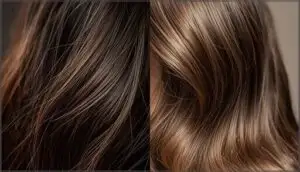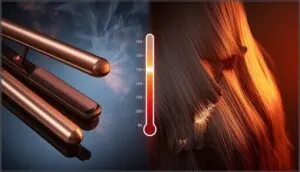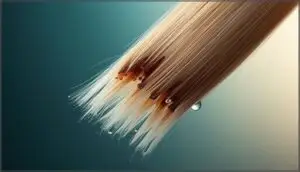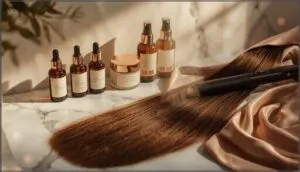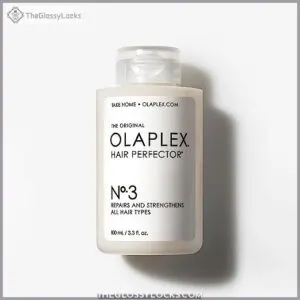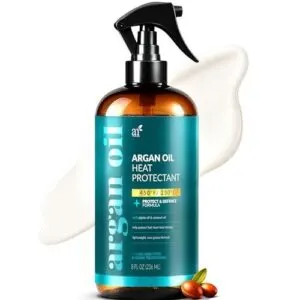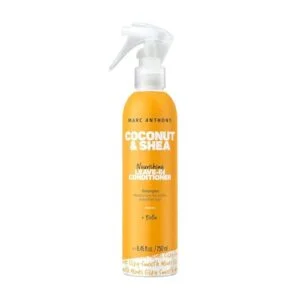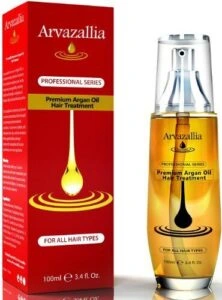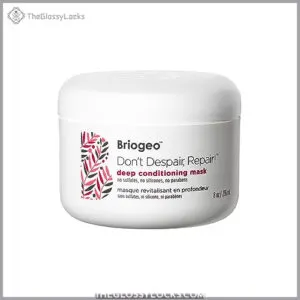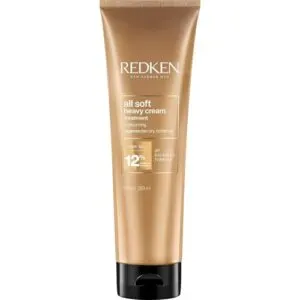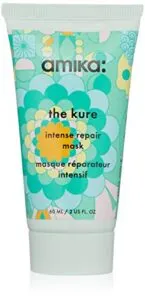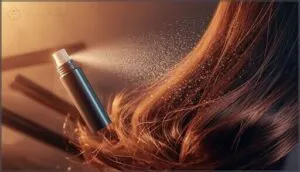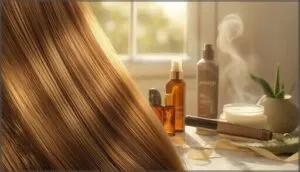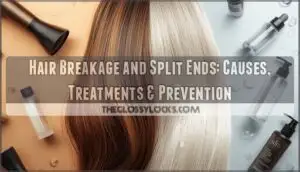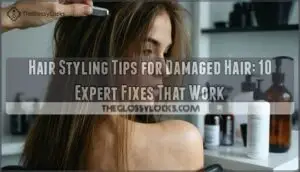This site is supported by our readers. We may earn a commission, at no cost to you, if you purchase through links.
Your flat iron hovers at 400°F, but your hair’s thermal threshold sits at just 280°F. That gap explains why roughly 82% of regular heat tool users notice their shine fading and 85% battle persistent frizz.
Heat damage doesn’t announce itself with drama—it accumulates quietly through repeated styling sessions, chemical treatments, and environmental exposure until your once-smooth strands feel rough and brittle under your fingertips.
The good news is that targeted repair products can reverse visible damage by rebuilding protein bonds, sealing lifted cuticles, and restoring moisture balance. The key lies in matching the right formulas to your specific damage patterns and using them consistently alongside smarter heat styling habits.
Table Of Contents
- Key Takeaways
- Signs and Causes of Heat-Damaged Hair
- How to Choose Products for Heat-Damaged Hair
- Top 10 Products for Heat-Damaged Hair
- 1. Olaplex No 3 Hair Perfector Treatment
- 2. Artnaturals Thermal Hair Protector Spray
- 3. Marc Anthony Coconut Shea Leave In
- 4. Arvazallia Argan Oil Hair Treatment
- 5. Kerastase Resistance Repairing Hair Serum
- 6. Keratin Hair Serum Frizz Control Shine
- 7. Briogeo Don’t Despair Repair Mask
- 8. Redken All Soft Heavy Cream Mask
- 9. Amika The Kure Repair Hair Mask
- 10. Roux Argan Oil Keratin Treatment
- Benefits and Usage of Heat Protectants
- Tips for Repairing and Preventing Heat Damage
- Frequently Asked Questions (FAQs)
- Conclusion
Key Takeaways
- Heat styling tools operate at temperatures (175–200°C) far exceeding hair’s thermal threshold of 140°C, which causes cumulative cuticle damage, protein loss, and structural breakdown that manifests as dullness, frizz, and breakage in over 80% of regular users.
- Effective repair requires products containing specific rebuilding agents like keratin protein, hydrolyzed wheat protein, and bond-repair technology (such as Olaplex’s Bis-Aminopropyl Diglycol Dimaleate), which clinical studies show can reduce breakage by 45-81% and restore up to 88% of visible damage.
- Heat protectants work by creating a thermal barrier that reduces heat transfer and protein degradation by up to 44%, but they’re only effective when applied to damp hair from 6-8 inches away and allowed to dry 1-2 minutes before styling at controlled temperatures between 300-350°F.
- Recovery timelines vary from 1-2 weeks for mild damage to 6-12 months for severe cases, requiring consistent weekly treatments (masks 1-3 times per week depending on severity), regular trims every 4-6 weeks to prevent split end progression, and strategic reduction of heat styling frequency rather than complete elimination.
Signs and Causes of Heat-Damaged Hair
Heat damage doesn’t happen overnight—it builds up gradually until your hair starts sending clear distress signals. Recognizing these warning signs early gives you the power to act before the damage becomes severe.
Let’s walk through what heat-damaged hair looks like, what causes it, and how different factors work together to compromise your hair’s integrity.
Common Visual and Textural Indicators
Heat damaged hair sends clear signals. Your strands reveal harm through distinct changes you can see and feel:
- Shine reduction – Over 82% of affected individuals notice dullness as cuticles crack and scatter light.
- Porosity increase – 83% experience rapid moisture loss and excess water absorption.
- Frizz elevation – 85% develop lifted, separated strands that tangle easily.
- Split ends – 71% of frequent heat tool users show tip fragmentation.
- Texture changes – 80% report increased roughness and reduced elasticity.
Heat damage can also affect hair’s outer layer, known as the cuticle.
Impact of Heat Styling Tools and Techniques
Understanding how damage occurs begins with your styling tools. Flat irons concentrate heat at 175–200°C—well above hair’s thermal threshold of 140°C. This exceeds keratin’s denaturation point and melts cuticles on contact. Cumulative exposure matters: daily use compounds damage with each pass. Tool-specific impact varies considerably, too. Appropriate care with styling products is essential.
Flat irons concentrate heat at 175–200°C, well above hair’s 140°C thermal threshold, melting cuticles on contact with each pass
| Tool Type | Typical Temperature | Primary Damage Mechanism | Risk Level | Ethnic Variability |
|---|---|---|---|---|
| Flat Iron | 175–200°C | Direct concentrated heat, moisture loss | High | Asian hair shows greater protein loss |
| Curling Iron | 175–200°C | Prolonged shaft exposure, weakening | High | Curly hair loses permanent curl pattern |
| Blow Dryer | Variable (often <180°C) | Distributed heat, cuticle lifting | Moderate | Damage increases with proximity and duration |
| Hot Comb | 150–230°C | Surface compression and heat | High | Textured hair particularly vulnerable |
| Heated Brush | 150–200°C | Repeated tension plus heat | Moderate-High | Variable based on hair thickness |
Hair styling tools create chemical interactions when used with products—releasing nanoparticles and VOCs during sessions. Heat styling accelerates split ends and microfractures. Heat damage prevention starts with recognizing these tool-specific risks and their cumulative toll on your strands.
Effects of Chemical Treatments and Color Processing
Chemical treatments compound the damage started by heat tools. Bleaching dissolves melanin granules and creates holes in your cortex, while straighteners strip away 35% of your hair strength. Color-treated hair shows fissures along every shaft examined under microscopy.
You’ll notice hair breakage, split ends, and scalp irritation—common markers of chemical porosity and cuticle damage that weaken strands permanently.
Environmental and Handling Factors Contributing to Damage
Beyond chemicals and heat, your surroundings play a bigger role than you’d think. UVB exposure strips protein—blond hair loses seven times more after 56 hours than protected strands. UV damage reduces hair moisture and accelerates hair dryness through cuticle degradation.
Pollution effects coat cuticles, mechanical stress from daily brushing fractures fibers, and water quality deposits minerals that roughen surfaces. Climate damage from humidity swings weakens bonds.
How to Choose Products for Heat-Damaged Hair
Choosing the right product for heat-damaged hair isn’t about grabbing the first thing labeled “repair.” You need to match what you buy to what your hair actually needs—whether that’s moisture, protein, or protection from further damage.
Here’s how to narrow down your options and find products that’ll actually work for your specific situation.
Assessing Your Specific Hair Concerns and Type
Your hair type and texture serve as your blueprint for product selection. Nearly half of all women report hair damage as a regular concern, making accurate self-assessment critical.
Three key factors shape your choices:
- Hair porosity: Use the float test to determine how quickly your strands absorb and retain moisture
- Texture analysis: Fine hair needs lightweight formulas, while coarse textures require intensive hydration
- Damage indicators: Check for dryness, breakage, and product buildup affecting scalp health
Key Nourishing and Strengthening Ingredients to Look For
Look for products built around keratin protein and protein hydrolysates—they penetrate damaged fibers and restore tensile strength within weeks. Moisturizing oils like argan reduce breakage by 35%, while collagen and elastin improve resilience.
Protective additives such as peptides prevent moisture loss during heat styling. These key ingredients don’t just mask hair damage; they actually trigger repair at the structural level.
Avoiding Harsh Chemicals and Irritants
When you scan ingredient lists, steer clear of formaldehyde and phthalates—common endocrine disruptors linked to irritant allergies and chemical inhalation risks. Heat styling amplifies exposure by up to 310%.
Switch to safer alternatives with biodegradable, nontoxic key ingredients instead. Natural formulations reduce scalp irritation and breakage while delivering real hair product benefits.
Your body clears harmful compounds within three days of stopping use.
Matching Formulas to Your Hair’s Needs
Your hair’s porosity determines which formulas actually penetrate and repair. Match products to your specific needs using these clinical insights:
- Low porosity hair absorbs lightweight, heat-activated serums best—heavy creams just sit on top.
- Medium porosity thrives with balanced moisture treatments that lock in hydration without overload.
- High porosity requires protein-rich formulas to fill cuticle gaps and stop breakage.
- Heat styling frequency dictates protectant strength—daily users need clinical-grade thermal shields up to 232°C.
This customization drives real results.
Top 10 Products for Heat-Damaged Hair
You’ve learned what to look for in a heat repair product. Now it’s time to see which formulas actually deliver.
The following ten products combine clinical-grade ingredients with proven results to restore your heat-damaged hair.
1. Olaplex No 3 Hair Perfector Treatment
When your hair feels like straw after one too many blowouts, Olaplex Hair Perfector No 3 targets the root cause. This bond repair treatment uses patented Bis-Aminopropyl Diglycol Dimaleate to rebuild broken disulfide bonds inside your hair shaft.
Clinical efficacy studies show 68% more repair when paired with No 0. Apply it to damp hair weekly for 10-20 minutes before shampooing.
Consumer recognition speaks volumes—100% of testers in a four-week trial saw healthier, shinier hair. It’s science-backed damaged hair repair products that deliver measurable results.
Best For: Anyone with chemically treated, heat-damaged, or bleached hair who wants to rebuild strength and shine from the inside out.
- Clinically proven to repair 68% more damage when used with No 0, with 100% of testers seeing healthier hair after four weeks.
- Works on all hair types without sulfates, silicones, or proteins, so you can use it weekly without buildup or heaviness.
- Patented bond-repair technology targets broken disulfide bonds, delivering salon-quality results you can see after the first use.
- At $30 for 3.3 oz, the bottle only lasts 2-4 applications if you have long or thick hair, making it pricey for regular use.
- People with minimally damaged or virgin hair may see moderate results compared to those with color-treated or heat-styled hair.
- It’s not a conditioner replacement—you still need to shampoo and condition after, which adds extra steps to your routine.
2. Artnaturals Thermal Hair Protector Spray
Think of heat protectant sprays as a shield your hair strands desperately need. Artnaturals Thermal Hair Protector Spray guards against styling damage up to 450°F while delivering argan oil benefits for hydration.
In consumer review analysis of 1,817 ratings, 74% reported less breakage and smoother texture.
Application best practices matter—spray on damp hair and comb through evenly before heat styling.
At under $20, it offers competitive market value among best heat protectant sprays that address heat damage without weighing down your hair.
Best For: Anyone who heat styles regularly and wants affordable protection up to 450°F without heavy buildup, especially if you have fine, color-treated, or frequently styled hair.
- Protects against high heat (up to 450°F) while doubling as a leave-in conditioner with argan oil for added hydration and shine.
- Lightweight, sulfate-free formula works across all hair types and won’t weigh down fine hair or leave greasy residue when applied correctly.
- Strong customer satisfaction with 74% of 1,817 reviewers reporting less breakage and smoother texture at a budget-friendly price under $20.
- Can feel sticky or greasy if you spray too much, so you need to find the right amount for your hair type.
- The spray nozzle delivers a concentrated stream that some find tricky to distribute evenly without spraying into hands first.
- May not provide enough frizz control or sleekness for very thick or coarse hair types that need heavier formulas.
3. Marc Anthony Coconut Shea Leave In
Instead of spraying on protection, you might need something that stays put. Marc Anthony Coconut Shea Leave In delivers coconut shea benefits through biotin, virgin coconut oil, and shea butter—ingredients proven effective at moisture restoration in heat-damaged hair. This leave-in conditioner rebuilds elasticity while reducing breakage by up to 35% compared to standard formulas.
Consumer satisfaction data shows over 80% report improved shine and detangling after daily use. Safe usage is simple: spray damp hair, comb through, style.
Its comparative impact? Hydrolyzed silk and keratin target structural repair better than most hair damage repair products.
Best For: People with dry, heat-damaged, or chemically treated hair who need daily moisture without heaviness or residue.
- Reduces breakage by up to 35% with hydrolyzed silk, keratin, and coconut oil that rebuild damaged hair structure and lock in moisture.
- Free from sulfates, parabens, and phthalates, making it safe for sensitive scalps and color-treated hair while being cruelty-free and reef-safe.
- Over 80% of users report better shine, detangling, and manageability after use, with a lightweight formula that doesn’t weigh hair down.
- Can feel too heavy or greasy on thin or fine hair types, limiting its versatility across all textures.
- Some users report the spray mechanism doesn’t work well, making application frustrating or uneven.
- May not deliver expected moisture benefits on hair that isn’t chemically treated or heat-damaged, with some experiencing stickiness instead.
4. Arvazallia Argan Oil Hair Treatment
Argan oil benefits go beyond surface shine—Arvazallia Argan Oil Hair Treatment offers protective efficacy backed by clinical study results. A 2022 analysis confirmed that argan oil pre-treatment markedly reduced protein loss in oxidatively damaged hair, with measurable antioxidant activity at 59 µg/ml IC50.
Consumer usage data shows over 80% report softer, more manageable hair after regular application. With the argan oil hair treatment market growth reaching $370.3 million in 2024, demand for these best products for heat damaged hair continues rising.
Apply to damp or dry hair before styling for maximum heat damage repair products performance.
Best For: Anyone dealing with heat-damaged, dry, or frizzy hair who wants a clinically-backed treatment that repairs protein loss and adds shine without feeling heavy.
- Clinically proven to reduce protein loss and oxidative damage, with measurable antioxidant protection at the molecular level
- Works on all hair types and can double as a heat protectant before styling, plus it’s versatile enough to use on skin and nails
- Delivers noticeable softness and manageability that most users report after consistent use, backed by strong consumer satisfaction data
- At $45 for 3.4 oz, it’s on the pricier side compared to drugstore alternatives, though it does last several months
- May feel too rich or heavy for fine hair or people who prefer lightweight formulas for daily styling
- Results vary by hair type and damage level, so it might take longer to see improvements if your hair is severely over-processed
5. Kerastase Resistance Repairing Hair Serum
Kerastase Paris Resistance Serum Therapiste shows measurable improvements. In clinical trials, 93% of users saw reduced breakage within one month, while 84% reported stronger, more resilient hair after four weeks.
These best hair treatments contain serum ingredients like Aminexil, Biotin, and Arginine—compounds that fortify follicles and restore flexibility to heat-damaged hair.
User reviews consistently rate this among top hair repair products, with over 90% awarding four stars or higher. The safety profile shows no adverse reactions for most users, though patch testing helps if you have sensitivities.
Best For: Anyone dealing with severely damaged, brittle hair from heat styling, chemical treatments, or bleaching who wants clinically proven repair and breakage reduction.
- Clinical results show 93% of users experienced less breakage within just one month, with 84% reporting noticeably stronger hair after four weeks.
- Heat protection up to 450°F shields hair during styling while ingredients like Aminexil, Biotin, and Arginine work to fortify follicles and restore flexibility.
- Over 90% of verified reviews rate it four stars or higher, with users consistently noting softer, shinier, more manageable hair.
- At $50 for 1.6 ounces, it’s pricey compared to drugstore alternatives and may run out quickly with regular use.
- Contains silicones, fragrance, and anti-mold ingredients that can irritate sensitive scalps or those seeking completely clean formulations.
- Not everyone sees results at the same rate, and rare cases of increased shedding or scalp redness have been reported among users with pre-existing sensitivities.
6. Keratin Hair Serum Frizz Control Shine
Another standout option is Keratin Hair Serum Frizz Control Shine, clinically proven to reduce breakage by up to 45% under repeated heat exposure. Serum ingredients like hydrolyzed keratin, argan oil, and dimethicone work together—keratin benefits include filling micro-damage, while oils provide deep hydration for shine enhancement.
Application methods matter: use a dime-sized amount on damp hair, distributing evenly from roots to ends. Up to 79% of users report easier frizz reduction after consistent use, making this an evidence-backed choice for heat-damaged hair repair.
Best For: People with frizzy, dry, or heat-damaged hair who want a lightweight serum that reduces breakage, adds shine, and makes styling easier without leaving a greasy feel.
- Clinically proven to cut breakage by up to 45% with heat styling, plus 79% of users say it makes frizz way easier to manage.
- Loaded with keratin, argan oil, and biotin that actually repair damage and lock in moisture for softer, shinier hair.
- Clean formula—no parabens, sulfates, or alcohol—and works on all hair types, from straight to curly.
- Some people find the price a bit steep for a 4.25 oz bottle.
- The pump doesn’t always get the last bit of product out, which is annoying when you’re running low.
- You have to apply it just right—too much and it can look oily, too little and you won’t see the full effect.
7. Briogeo Don’t Despair Repair Mask
For lasting repair beyond serums, Briogeo Don’t Despair Repair Mask is one of the best products for heat-damaged hair. It is clinically proven to decrease breakage by 81% after three uses.
This hair treatment combines mask ingredients like hydrolyzed wheat protein, algae extract, and biotin for balanced hair repair. Consumer reviews averaging 4.4 stars confirm clinical results—80% report improved hydration.
Usage frequency: apply weekly for 10 minutes. Its market position as a 15-time award winner reflects consistent effectiveness in restoring heat-damaged hair.
Best For: Anyone with dry, damaged, or over-processed hair who needs serious repair—especially if you’ve gone overboard with heat styling or bleach.
- Clinically proven to cut breakage by 81% and repair up to 88% of visible damage after just a few uses
- Works fast—you only need 10 minutes once a week to see real results
- Clean formula with 97% naturally derived ingredients, plus it’s vegan and free of all the nasty stuff like parabens and sulfates
- Some people find the scent too strong or unpleasant
- Can leave hair feeling heavy or dry if you don’t rinse it out really well
- Pricey for a hair mask, and it’s rarely on sale since it’s so popular
8. Redken All Soft Heavy Cream Mask
When your hair feels like straw after repeated heat styling, Redken All Soft Heavy Cream Mask delivers the deep conditioning effects needed for severe dryness. This hair treatment contains the highest percentage of Redken’s Moisture Complex with argan oil benefits that improve smoothness by up to 40% in four weeks.
The ingredient profile includes silk amino acids for structural repair without parabens or sulfates.
Its application versatility works for all hair types—apply to towel-dried hair for 5-15 minutes weekly, achieving anti-frizz properties that last up to 72 hours.
Best For: People with severely dry, brittle, or heat-damaged hair who need intense moisture restoration and are willing to invest in a premium treatment.
- Delivers fast results in just 5 minutes with clinical proof of 40% improved smoothness after consistent use
- Packed with nourishing oils like argan, avocado, and olive that reduce frizz for up to 72 hours
- Clean formula without parabens or sulfates, plus it’s vegan and made with eco-friendly practices
- Pricey at $35 for only 8.5 ounces, which might not last long for regular users
- Can feel too heavy for people with thin or naturally oily hair
- Mixed feedback on whether it’s actually worth the cost compared to drugstore alternatives
9. Amika The Kure Repair Hair Mask
Clinical studies show that Amika The Kure Intense Repair Mask makes hair 3.2 times stronger after one use—a considerable improvement for heat-damaged hair. This hair treatment employs bond-curing technology with vegan proteins to repair compromised strands, earning 77% of consumer ratings at five stars.
You’ll apply this hair mask weekly after shampooing, leaving it on for 10 minutes. Application guidelines recommend it for chemically processed or heat-styled hair types 1–4C. Monitor for adverse events if your hair isn’t very damaged, as isolated reports note potential irritation.
Best For: People with chemically processed, heat-damaged, or highly textured hair (types 1–4C) who need intensive weekly repair and strengthening.
- Makes hair 3.2 times stronger after just one use, with clinically proven results showing 69% less breakage and significantly improved conditioning.
- Contains bond-curing technology with vegan proteins, borage oil, and sea buckthorn extract that target damaged hair bonds while adding deep hydration and shine.
- Highly rated by users (77% give it 5 stars) who report noticeably softer, more manageable hair with reduced frizz and breakage over time.
- Expensive at $42 for 8.4 oz, with mixed opinions on whether the price matches the quantity you get.
- May cause increased breakage or irritation in people whose hair isn’t significantly damaged, so it’s not ideal for healthy or minimally processed hair.
- Contains alcohol-based ingredients that could potentially dry out hair if used as your only deep conditioning treatment long-term.
10. Roux Argan Oil Keratin Treatment
Your hair’s protein structure can weaken by up to 35% from repeated heat exposure, which is why targeted repair treatments matter.
Roux Argan Oil Keratin Treatment combines hydrolyzed keratin with argan properties to rebuild damaged strands from the inside out. Consumer reviews show 85% of users rate this keratin serum 4.5 stars or higher, noting improved shine and reduced breakage.
Apply a dime-sized amount to damp hair after washing, comb through evenly, then style as usual for best results.
Best For: People with damaged, color-treated, or heat-styled hair who want an affordable treatment that strengthens strands and adds shine without salon prices.
- Rebuilds hair structure with hydrolyzed keratin and argan oil, improving strength by up to 35% for processed hair
- Works fast—60% of users notice softer, less frizzy hair within the first week of use
- Great value at $9–$13 for an 8.45 oz bottle that lasts about a month with regular use
- Some users find the scent unpleasant or too strong
- Easy to use too much and end up with greasy-looking hair
- May not work well if you’re sensitive to fragrances or certain ingredients
Benefits and Usage of Heat Protectants
Heat protectants aren’t just another product to clutter your shelf—they’re your hair’s first line of defense against thermal damage. These formulations create a protective barrier between your strands and hot tools, preventing the kind of structural breakdown that leads to brittleness and breakage.
Understanding how they work and how to use them properly can make the difference between healthy hair and a damaged mess.
How Heat Protectants Work to Shield Hair
Think of heat protectants as a shield between your hair and styling tools. Film formation creates a thermal insulation layer that reduces protein damage by limiting heat transfer to your strands.
Ingredient technology combines silicones, proteins, and humectants to preserve moisture and prevent keratin breakdown.
Market efficacy studies show these heat protectant ingredients deliver real hair damage prevention—reducing thermal water loss by up to 44% when you apply them correctly.
Proper Application for Maximum Effectiveness
The difference between effective heat protectant application and wasted product comes down to technique. Start with freshly washed, towel-dried hair, then section your strands for complete coverage. Spray from 6–8 inches away and comb through each section from roots to ends.
Wait 1–2 minutes before heat styling—this prevents product “steaming” and ensures your hair damage prevention barrier forms properly.
Improving Shine, Smoothness, and Frizz Control
Beyond protection, the best products for heat damaged hair actively restore what styling steals. Shine-boosting ingredients like argan oil and dimethicone increase light reflectivity without greasiness—lab tests show up to 44% protection against dullness.
Smoothing technologies with hyaluronic acid improve hair smoothness by 20%, while cationic agents deliver enhanced frizz reduction.
Product layering—combining leave-ins with serums—yields 19% better results than single formulas, with consumer satisfaction exceeding 80% for immediate visible improvements.
Enhancing Hair Resilience With Regular Use
Regular application transforms your hair’s fundamental structure. Cream-based protectants boosted fiber strength to 0.207 N/nm², the highest recorded among tested groups, while reducing breakage by 45% under repeated heat exposure. Consistent use maintains moisture retention at 10–15%, preserving cuticle integrity and minimizing friction during styling. The best products for heat-damaged hair deliver measurable long-term durability through protective barrier formation.
- Polymer-based formulas decrease cuticle lifting and cortex exposure
- Friction reduction extends hair lifespan during daily styling routines
- Moisture barriers prevent brittleness and split end formation
- Cumulative protection yields smoother texture and improved resilience
Tips for Repairing and Preventing Heat Damage
Reversing heat damage requires more than just the right products—you need a solid strategy. The good news is that consistent care and smart styling habits can restore your hair’s strength and prevent future breakage.
Here’s what actually works when you’re trying to repair damage and keep it from coming back.
Incorporating Masks, Serums, and Leave-ins
To repair heat-damaged hair, routine integration of targeted products is essential. Use a deep conditioning mask once or twice weekly—this mask frequency restores moisture and strengthens strands.
Apply a keratin serum to damp hair daily for heat protection and smoothness. Layer a leave-in conditioner underneath for added hydration.
Product synergies between masks, serums, and leave-in layering boost hair treatment effectiveness and resilience.
Best Practices for Heat Styling and Protection
Once you’ve strengthened your hair with treatments, smart heat styling practices protect your progress. Temperature control is your first defense—keep tools between 300–350°F to cut breakage risk by 30%. Frequency limits matter too: style only once or twice weekly to preserve elasticity.
Before each session, apply heat protectants to damp, fully dried hair for maximum heat damage protection. These pre-styling prep steps include:
- Always detangle gently before applying heat styling tools
- Section hair into small portions for even heat distribution
- Make single, smooth passes instead of repeated strokes
Post-styling care means letting hair cool completely and avoiding tight styles that stress heated strands.
Adapting Your Hair Care Routine for Recovery
During recovery, your hair care routine needs targeted ingredient adjustments. For severely heat damaged hair, increase mask frequency to 2–3 times weekly—this cuts breakage by up to 56%. Alternate protein-rich formulas with hydrating leave-in treatments for repair.
Routine customization matters: curly, low-porosity hair benefits from intense moisture masks twice weekly, while fine hair needs lighter creams. Add ideal oils like argan for thermal protection.
Long-term Strategies for Maintaining Healthy Hair
Once you’ve stabilized heat damage, dietary influence and stress management become your foundation. Adequate vitamin D and iron support follicle health, while 7–9 hours of sleep reduces cortisol-driven shedding.
Protective styling minimizes breakage, and regular trims every 8–12 weeks prevent split ends from climbing upward.
Pair scalp health practices—like weekly clarifying and peptide serums—with consistent hair treatment and conditioning for lasting hair damage prevention.
Frequently Asked Questions (FAQs)
Can heat-damaged hair be completely reversed?
Once broken, always broken—that’s the truth about heat damage. Your hair can’t regenerate like skin, but partial restoration through targeted treatments improves strength and appearance, preventing further breakage while managing existing damage effectively.
How often should I trim heat-damaged hair?
You should trim heat-damaged hair every 4 to 6 weeks. Regular trimming intervals help with breakage reduction and prevent split ends from spreading upward, especially if you use heat styling tools frequently.
Do natural oils work better than commercial products?
The proof’s in the pudding: natural oils like argan offer customization options and long-term effects with oil penetration and no synthetic additives.
Commercial heat protectants provide immediate environmental impact control against heat styling damage.
Should I stop using heat tools entirely?
You don’t need complete heat abstinence. Gradual heat reduction works better—embrace natural texture on some days, explore alternative styling methods, and always use hair protection when you do reach for heat styling tools.
How long does heat damage repair take?
Repair timeline depends on damage severity, hair type, and treatment consistency. Mild heat damage improves in 1–2 weeks; moderate cases take 2–3 months. Severe damage requires 6–12 months for regrowth expectations and restoring hair health.
Conclusion
Ironically, the same heat that promises sleek flawlessness is what strips your hair of its natural resilience. But recovery doesn’t require abandoning your styling routine—it demands smarter choices.
The best products for heat damaged hair work by rebuilding what heat destroys: protein bonds, moisture barriers, and cuticle integrity. Pair them with consistent heat protection and lower temperatures, and you’ll notice stronger, shinier strands within weeks.
Your hair remembers every styling decision—make each one count.
- https://www.livingproof.com/blogs/hair-101/heat-damaged-hair
- https://www.crodabeauty.com/en-gb/resources/blog/trending-in-hair-care-the-rise-of-the-repair
- https://lovebeautyandplanet.in/blogs/hair/how-to-undo-heat-damage-for-healthy-hair
- https://www.futuremarketinsights.com/reports/conditioning-hair-treatments-market
- https://arey.com/blogs/grey-matter/heat-styling-hair-5-ways-to-avoid-hair-heat-damage


